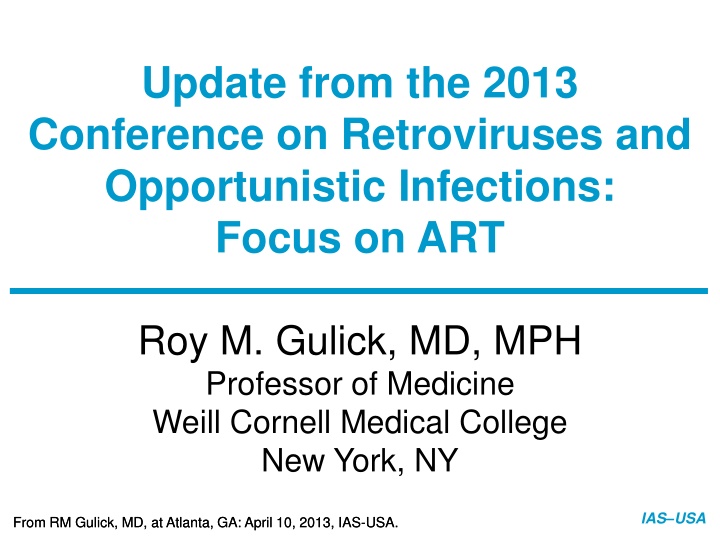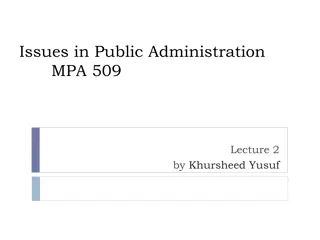
Update on ART and Drug Resistance in HIV Management
This presentation provides updates from the 2013 Conference on Retroviruses and Opportunistic Infections, focusing on antiretroviral therapy (ART) and drug resistance in HIV treatment. Key topics include a case study on a baby born to an HIV+ mother, ART drug resistance trends in the U.S., comparison of TAF vs. TDF in HIV treatment, and changes in bone mineral density. The findings discussed shed light on advancements and challenges in managing HIV.
Uploaded on | 0 Views
Download Presentation

Please find below an Image/Link to download the presentation.
The content on the website is provided AS IS for your information and personal use only. It may not be sold, licensed, or shared on other websites without obtaining consent from the author. If you encounter any issues during the download, it is possible that the publisher has removed the file from their server.
You are allowed to download the files provided on this website for personal or commercial use, subject to the condition that they are used lawfully. All files are the property of their respective owners.
The content on the website is provided AS IS for your information and personal use only. It may not be sold, licensed, or shared on other websites without obtaining consent from the author.
E N D
Presentation Transcript
Slide 1 of 12 Update from the 2013 Conference on Retroviruses and Opportunistic Infections: Focus on ART Roy M. Gulick, MD, MPH Professor of Medicine Weill Cornell Medical College New York, NY IAS USA From RM Gulick, MD, at Atlanta, GA: April 10, 2013, IAS-USA. From RM Gulick, MD, at Atlanta, GA: April 10, 2013, IAS-USA.
Slide 2 of 12 Oh, Baby! Mother presented in labor, unaware of HIV status, found HIV+ Baby treated with 3-drug ART (ZDV/3TC + NVP) within 30 hours Mother VL 2K, baby VL 20K Matched wild-type virus, subtype B Baby HIV RNA decreased at days 7, 12, 20, then <20 at day 29 HIV RNA continued <20 cps/ml X 16 determinations Mother and baby lost-to-follow-up; ART stopped at 18 months Re-presented for follow-up HIV RNA <20 copies/ml (1 copy/ml) at 24 months HIV DNA 4 copies / 1 million PBMC at 26 months No replication-competent virus HIV Antibody negative Cure(?) Persaud CROI 2013 #48LB From RM Gulick, MD, at Atlanta, GA: April 10, 2013, IAS-USA.
Slide 3 of 12 CDC: U.S. ART Drug Resistance 2007-2010 Study population: Convenience sample of newly diagnosed HIV+ without prior ART use in 10 U.S. surveillance areas reported to the CDC through 6/11 Assessed NRTI, NNRTI and PI mutations 18,144 patients had viral sequences assessed 2932 (16%) of patients had 4788 drug mutation sequences Of these viral sequences 14% 1-class resistance; 2% 2-class; 0.5% 3-class 7% to NRTIs; 8% to NNRTIs; 4% to PIs Estimated annual change for any 1 mutation not significant (3%, p=0.06) Significant increases in 1-class mutations (4%, p=0.01) NNRTI mutations (5%, p=0.03) From RM Gulick, MD, at Atlanta, GA: April 10, 2013, IAS-USA. Kim CROI 2013 # 149
Slide 4 of 12 TAF vs TDF Phase 2,Week 24 Analysis Study population: Rx-na ve, VL >5000, CD4 >50 (N=170) % Subjects VL <50 c/mL 100 TDF/FTC/EVG/c 90% (n=58) 90 80 TAF/FTC/EVG/c 88% (n=112) 70 60 50 40 30 20 10 0 16 24 2 12 4 8 Time (Weeks) Change in serum creatinine at Week 24 TAF +0.07 mg/dL TDF +0.12 mg/dL (p=0.02) From RM Gulick, MD, at Atlanta, GA: April 10, 2013, IAS-USA. Zolopa CROI 2013 # 99LB
Slide 5 of 12 Percent Change in Bone Mineral Density (DEXA) GS-US-292-0102 Week 24 Analysis SPINE HIP 2 2 Mean % change in BMD Mean % change in BMD 0 0 -0.3% p < 0.001 -0.8% p = 0.002 -2 -2 -2.0% -2.5% 0 12 24 0 12 24 Time (Weeks) Time (Weeks) Proportion of subjects with no decrease in BMD Spine: TAF 38% TDF 12% Hip: TAF 41% TDF 23% From RM Gulick, MD, at Atlanta, GA: April 10, 2013, IAS-USA. Zolopa CROI 2013 # 99LB
Slide 6 of 12 Second-Line Study: LPV/r + [NRTIs or RAL] Design: Randomized, open-label non-inferiority study (margin 12%) Study population: HIV+ patients who failed a 2 NRTI + NNRTI regimen with no prior PI or RAL (N=541) Baseline: 55% men; 42% Asian, 36% African, 14% Hispanic; VL 4.2 log; CD4 211; 47% prior AIDS illness Study rx: LPV/r + 2-3 NRTIs (most common regimen TDF + FTC/3TC 46%; genotyping used in 73%) or RAL Results (week 48): HIV RNA <200: 81% (NRTIs) vs. 83% (RAL) p=0.59 HIV RNA <50: 70% (NRTIs) vs. 71% (RAL) CD4: +114 (NRTIs) vs. +150 (RAL) (p=0.01) Treatment d/c: 29 (NRTIs) vs. 28 (RAL) Grade 3/4 events: 28 (NRTIs) vs. 19 (RAL) Conclusion: RAL non-inferior to NRTIs as second-line rx with a PI/r From RM Gulick, MD, at Atlanta, GA: April 10, 2013, IAS-USA. Boyd CROI 2013 #180LB
Slide 7 of 12 MK-1439: Phase Ib Double-blind, randomized, placebo-controlled Study population: HIV+, treatment-na ve (N=18) Anderson, CROI 2013; #100 From RM Gulick, MD, at Atlanta, GA: April 10, 2013, IAS-USA.
Slide 8 of 12 BMS-663068: Oral HIV Attachment Inhibitor Study pop: CD4 >200, VL >5000 off ART X >8 wks or ART-naive (N=50) Prodrug of BMS-626529 Inhibits CD4 binding by binding to gp120 PK suggest QD or BID dosing without boosting baseline susceptibility in some pts due to envelope polymorphisms; screened by baseline IC50 Nettles JID 2012;206:1002 From RM Gulick, MD, at Atlanta, GA: April 10, 2013, IAS-USA.
Slide 9 of 12 Cenicriviroc (CVC) 202: Phase 2 VL <50 copies/mL (ITT-FDA Snapshot) 100 Study population: Rx-na ve, VL >1000, CD4 >200, documented R5 virus (N=143) All arms with TDF/FTC 76% 73% 71% 80 Subjects with HIV-1 RNA SE) <50 c/mL, % ( 60 CVC 100 mg CVC 200 mg EFV 40 20 randomized 2:2:1 BL 1 2 4 8 12 16 20 24 Weeks CVC 100 mg (N=59) CVC 200 mg (N=56) EFV (N=28) 0 3 2 2 0 4 11 4 5 25 17 12 37 28 16 44 13 18 42 40 19 45 41 20 From RM Gulick, MD, at Atlanta, GA: April 10, 2013, IAS-USA. Gathe CROI 2013 #106LB
Slide 10 of 12 Cenicriviroc (CVC) Study 202 sCD14 Changes from Baseline SE) Mean change from baseline in EFV sCD14 levels,a x 106 ng/L ( CVC 100 mg CVC 200 mg 55 54 28 51 50 22 47 44 21 CVC 100 mg CVC 200 mg EFV From RM Gulick, MD, at Atlanta, GA: April 10, 2013, IAS-USA. Gathe CROI 2013 #106LB
Slide 11 of 12 GSK744 LAP: PrEP Study in Macaques Study population: male macaques (N=16) Study treatment: GSK 744LAP 50mg/kg X 2, 4 weeks apart Placebo Weekly SHIV rectal challenge X 8 Results (preliminary) GSK 744LAP: no infections Placebo: all infected Andrews CROI 2013 #24LB From RM Gulick, MD, at Atlanta, GA: April 10, 2013, IAS-USA.
Slide 12 of 12 TDF Intravaginal Ring for PrEP Polyurethane drug reservoir ring that contains 130 mg of TDF and delivers 2.3 mg/day; replaced every 28 days over 16 weeks 18 macaques (6 ring, 12 controls -- 6 real-time, 6 hx) Low-dose challenge model: once-weekly SHIV vaginally up to 16 weeks Results (over 16 weeks): 0/6 macaques with rings vs. 11/12 without rings infected (after median 4 exposures) (P<0.0004) Rings well retained and well-tolerated X 5 months Smith, CROI 2013 #25LB From RM Gulick, MD, at Atlanta, GA: April 10, 2013, IAS-USA.




















